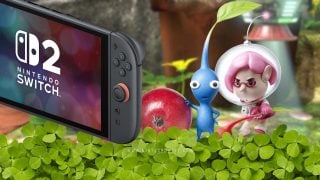Seeing the world through rose-colored glasses is not something I as a gamer am immune to. If anything, I’d argue I’m prone to it. Often, gamers are. So before I get into this review, I want to preface this by saying that I see Final Fantasy Crystal Chronicles through the pinkest, rosiest tinted glasses you can imagine — the kind that makes the whole world look like a pool full of red Gatorade. And I’ll be approaching this review from that perspective: as someone who’s played the original version more times than he can count, loves the game with his whole heart, and has frequently declared it as one of his Top 10 of all time.
Final Fantasy Crystal Chronicles as a whole is an exciting, interesting, and experimental romp through the Final Fantasy universe, though that’s about as much connection as it has to the other games in the franchise. And if you’re going into it looking for a genuine Final Fantasy experience, you’re in for a big ol’ Blizzaga to the face.
But first…
What is a Crystal Caravan?
So, young Padawan, you’ve decided to set out as your town’s Crystal Caravaner. Or, maybe the mayor told you it was your duty and you had to go. It’s kind of unclear, but it seems like, for the most part, you’re more than happy to oblige. That’s great! But what does that mean?
While the world of Crystal Chronicles is unnamed, it isn’t lacking in lore and backstory. For the most part, it’s entirely engulfed in a mysterious and dangerous substance known by the people of the world as miasma, which will hurt and eventually kill anyone who is exposed for too long. The only known protection against miasma is through the game’s crystals, which inhabit the towns and cities of the world as well as adorn the Crystal Chalices which — you guessed it — Crystal Caravans… caravan around. The final piece of this puzzle is myrrh, which is obtainable via myrrh trees. This strange and powerful liquid is actually what gives the crystals their power to repel miasma and is subsequently what your character is out to collect and fill their Crystal Chalice with. By returning with a full chalice of myrrh, your character is able to help protect their hometown from the miasma for another year.
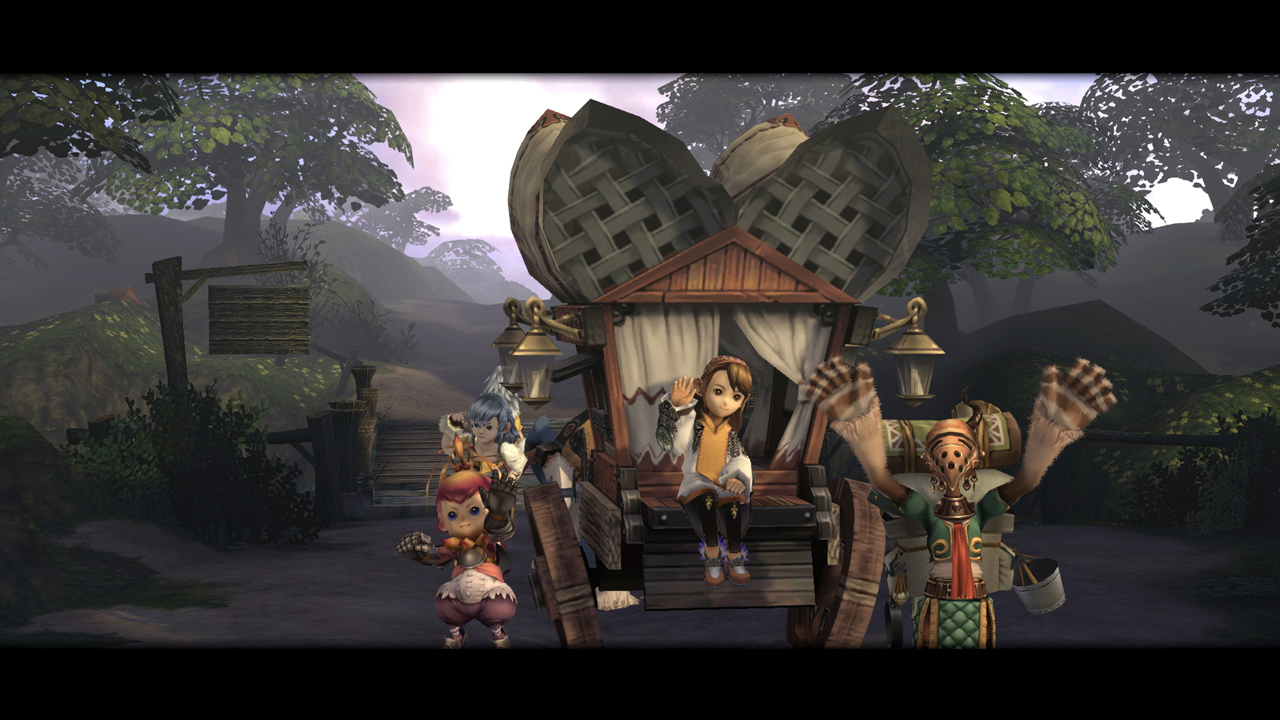
In the olden days (you know, back in 2004), a Crystal Caravan typically housed up to four caravaners from your hometown, who would travel along the overworld map on designated paths to reach dungeons where they would find the aforementioned myrrh trees. Along the way, you and your gang of friends and dungeon-crawling companions would cross paths with other caravaners and NPCs, recording memories of these encounters in your journal which would be recalled later at the end-of-year ceremony, once you’ve replenished your crystal’s power. During gameplay, it might sometimes feel as if these encounters are inconsequential, but the journal entries and memories do end up playing a much bigger role than one might expect at first. Plus, there are a lot of story beats that happen in these cutscenes, which end up making the game’s overall narrative feel a lot meatier than it otherwise would.
Ultimately, this is the main point and plot of the game. Because this is a remaster, I’m not going to get too heavy into the details past this, but I do think that knowing the general basis for the game and reasoning behind gameplay is important moving forward, so I do think it’s worth covering.
Setting out
As a Crystal Chronicles veteran, the most jarring thing about this remaster is just how lonely it feels; despite how supposedly easy it is to link up with others now. This game was inherently created with couch co-op in mind — everything about it was crafted specifically around this idea — so the decision to translate that innate multiplayer to a modern world was always going to be a risky and potentially unsuccessful jump. Now, that’s not to say that I’m mad about it, because the minute they announced this game and still even after release I’m excited that they did. But rather, I think it’s something that’s important to note and was always important to recognize when setting your expectations. This was never going to be a perfect recreation of the Crystal Chronicles experience because in the modern gaming landscape, that experience is near-impossible to replicate.
But back to what I was saying: even playing multiplayer, there’s a sense of loneliness that is extremely pervasive in the remaster that simply did not exist in the original, and this is due to a number of factors. Most notably, and perhaps most infamously at this point, is the inability to start and have a save file and hometown with the friends you’re playing alongside. Where story progression and caravanning used to be part of the multiplayer experience, dungeon crawling now occupies exclusively. Everything else is solely left to you. And yes, that means that if you and a friend want to progress each of your save files equally, you’ll have to both be hosts to the dungeons, swapping over and repeating content at some point or other. Progress doesn’t advance between all parties in a dungeon together.
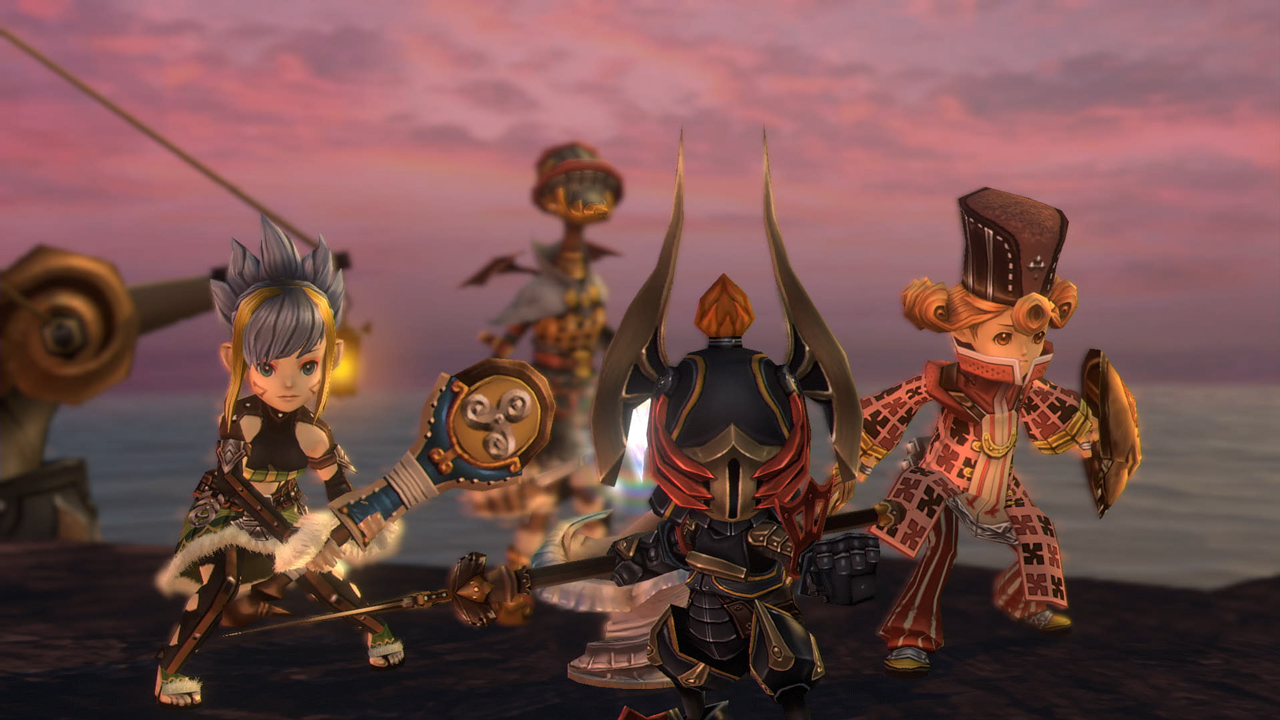
On one hand, I see the merit to this change. In the original, the gameplay outside of dungeons was always a bit clunky in multiplayer mode. Trying to coordinate four people to all move in the same direction in a town or agree on the next dungeon to play through had a tendency to be difficult, even with those players sitting right next to you. Online, I think this would be nearly impossible—even if you were on a voice chat with those other players. I can’t claim to understand all the inner-workings of game code and development, but I’d be willing to posit that making things like in-town shops (where, for example, only one player can speak to a shopkeep at a time) work online is probably more of a lift than we’re willing to believe.
This is a remaster after all, not a full remake, and I think reworking code and restructuring the way things work in-game to that extent was never necessarily in the cards. I want to stress that I don’t think it’s particularly unreasonable to ask for that considering the game is so heavily built around the multiplayer as a whole; but on the devil’s advocate side, I also think it is something that should be taken into consideration because the developers didn’t actually remove multiplayer from the core gameplay sections, i.e. the actual dungeons. They simply removed the clunky multiplayer from the interstitial sections of an otherwise dungeon-crawler video game, and I think that’s an important thing to remember when talking about the changes made to the multiplayer mode.
But, on the other hand, I can’t help but question why they couldn’t have made it a more integrated multiplayer experience. Stardew Valley in particular comes to mind in this instance, because that’s a game I’ve put a ton of hours into specifically with the multiplayer mode, and it works exactly as I’d want it to. I, as the host, have created a farm that the other players also contribute to and play in, and the entire save file is a shared experience among us. And sure, because I’m the host I have to be online specifically and actively hosting for everyone to play, and in theory I could play on that file by myself where they could not. But because I’ve started this file with others, a sort of unspoken pact has been made that I’m not going to mess with the file or play and progress without the other participants.
I can’t necessarily say that everyone would take to those unspoken rules the exact same way I would, but I can’t help but wonder why the developers of this remaster couldn’t have taken this approach. It’s clearly doable. Again, I’ll stress I don’t know how much tweaking and restructuring and straight up new coding would have had to be done in order to make this work, but we do know that, at the very least, it’s a functionality that exists and could have been implemented. And to a degree, it’s disappointing that they chose not to bother.
Inside the dungeons
As stated previously, the majority of the gameplay takes place within the game’s dungeons, with what I like to call “interstitial” areas in-between — such as cities and towns, Moogle houses, and the instantly recognizable miasma streams. And while there is some merit to the value of these interstitial areas, the game’s Meat and Gourd Potatoes really is in the dungeons and combat levels.
And here’s where things get tricky for me. Because, as much as I understand the gripes and complaints of the altered multiplayer functionality when it comes to story progression and non-shared save files, the places that I ultimately have the most fun are within these dungeons — and I still get to play those with my friends. In fact, I get to play those with my friends without having to worry about digging out my GBA SP and praying that it has some charge, or sifting through a drawer full of wires to hopefully, fingers crossed, find my Link Cable.

This doesn’t come without its own frustration, of course — the game’s multiplayer, despite the online connectivity, is still clunky to set up. And I suppose that’s just Crystal Chronicles’ plight. At the end of the day, the Final Fantasy gods have decided that you don’t get to play this game multiplayer without one hiccup or another. There are a lot of new added menus to the game to compensate for the new online aspects, but as a result it takes longer and is much more complicated than it should be to connect with your friends to do a single dungeon. Which, for what it’s worth, is another issue of mine. I don’t love how inconvenient it is to do more than one dungeon in one play session, because there’s no way of queueing up a whole bunch that you can run through at a time, instead having to completely disband the party and create a whole new play session to do the next dungeon on your list.
And again, my feelings are complicated because the game was created for an entirely different brand of multiplayer, and I’m willing to understand that. But I have to wonder: did Square Enix fully think these functionalities through before putting the game on shelves?
All that being said, once you get into the actual dungeons, it’s like returning to your childhood home. Sitting on a voice call and fighting through Mushroom Forest again, this time with friends who don’t and have never lived nearby, who I never would have been able to share this experience with prior, was… quite frankly, very exciting to me. And, like I’ve said a thousand times, that comes from a player who sees this game through the thickest cloud of miasma nostalgia, and so I realize not everyone is going to get that same feeling as me. But even without that, the dungeons in Crystal Chronicles are just plain FUN. And while you’re not really going to scratch any RPG itches with this one, if you’re a fan of real-time combat and teaming up with your friends to fight enemies and bosses, then you’re in for a treat.
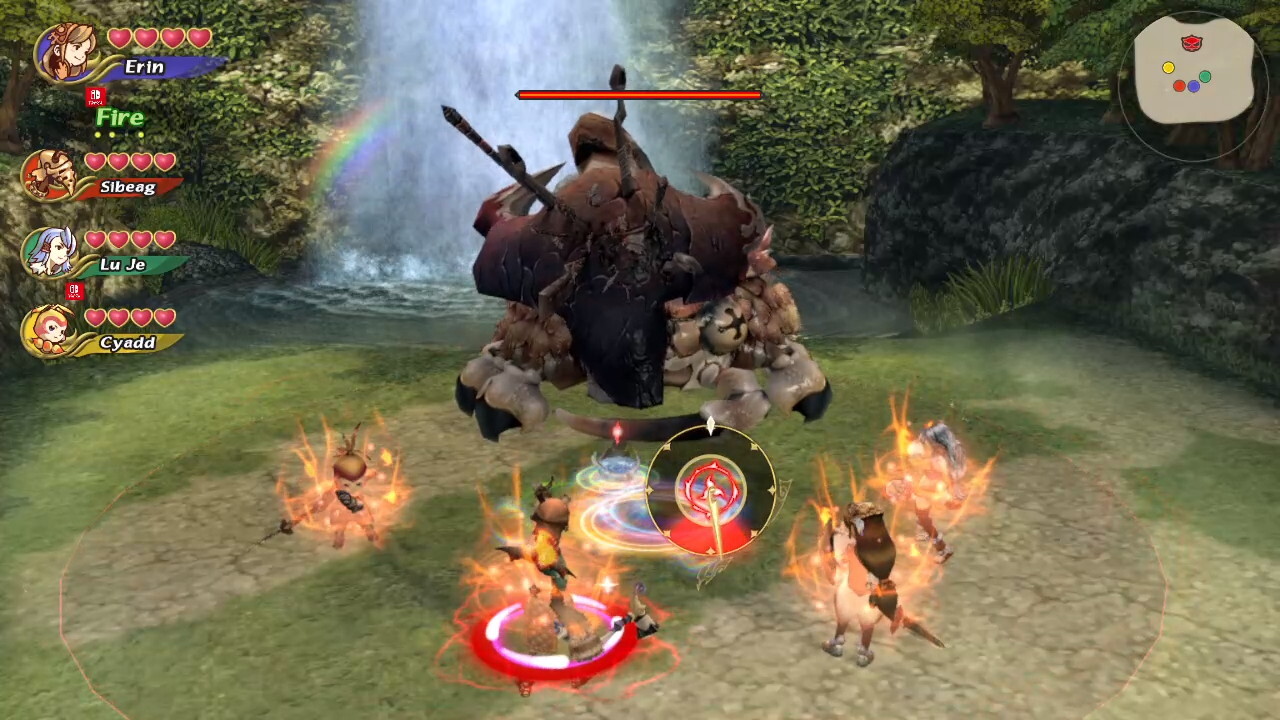
Combat is fluid, and simple enough that it’s easy and quick to grasp for anyone. But, it’s also engaging enough that it’s not particularly boring — especially when you combine the strengths of the four different tribes. I’m not much of a Yuke player myself, but I love playing alongside them because I find their magic usage a good compliment to my up-close-and-personal style of engaging with enemies. This is especially true later in the game, when it gets significantly harder, and I love having one character of every tribe on the battlefield to be able to attack an enemy or boss from all sides, with all different strategies.
What are the rewards?
And while we’re on the topic of playing with your friends, the remaster’s online multiplayer does have some interesting value that I haven’t seen a lot of discussion about. For one, long gone are the days of fighting your friends for the single Warrior’s Weapon scroll, or the rare material drop, or the 250 gil that popped out of the most recent treasure chest. Spoils are shared amongst the entire party in every dungeon, spare the Magicite you find (which disappears from your inventory after every dungeon, anyway). This allows for much more balanced gameplay among all your friends when playing together, because now everyone gets to be excited about crafting a new, more powerful weapon for the next boss fight, and no one has to worry about not having the right materials because the friend next to you snagged the mythril out from under your nose.
This extends to the end-level rewards, too, though not quite in the same way you’d expect. The reward wheel works the same as it did in the past — the person with the most bonus points at the end of the level picks an artifact or material, and each person following gets to choose from the leftovers. However, if you’re dedicated to playing with your friends and also progressing everybody’s story, you’ll find that you’re doing the same dungeons more than once, which means the Moogle Pocket from the end of River Belle Path will end up being yours eventually, even if you have to wait until the third or fourth run because all your other friends grabbed it first. But in the meantime, you were picking up stat-boosting artifacts, which is what they’re grabbing now. Do you see where I’m going with this?
Crystal Chronicles is a game that benefits from grinding, and the difficulty spike in the latter half of the game—especially for the final boss—is nothing to laugh at. I’ve found that every time I’ve played this game in the past, I’ve needed to grind dungeons I’ve done before for more artifacts to boost my stats. Having to repeat levels in this game is not a detriment in the long run, and I think just like any other RPG, it was probably intended to an extent. So while it might be frustrating to not progress the story because your friend is hosting and getting the myrrh this time around, try to remember that you’d probably be grinding Goblin Wall plenty more times at some point, anyway.
And what about single-player?
Because Crystal Chronicles was never a game that was meant or built around a single-player campaign, I’m not going to go into huge detail about the single-player mode —but I do think it’s worth touching on.
I want to start but saying that I encourage you to play this game with friends if possible. Crystal Chronicles is made ultimately better with a bigger party, even without that communal shared save file aspect. Don’t skip out on the multiplayer by any means, because it really is integral to the game’s experience. But with that being said…
The single-player is really fun, too.
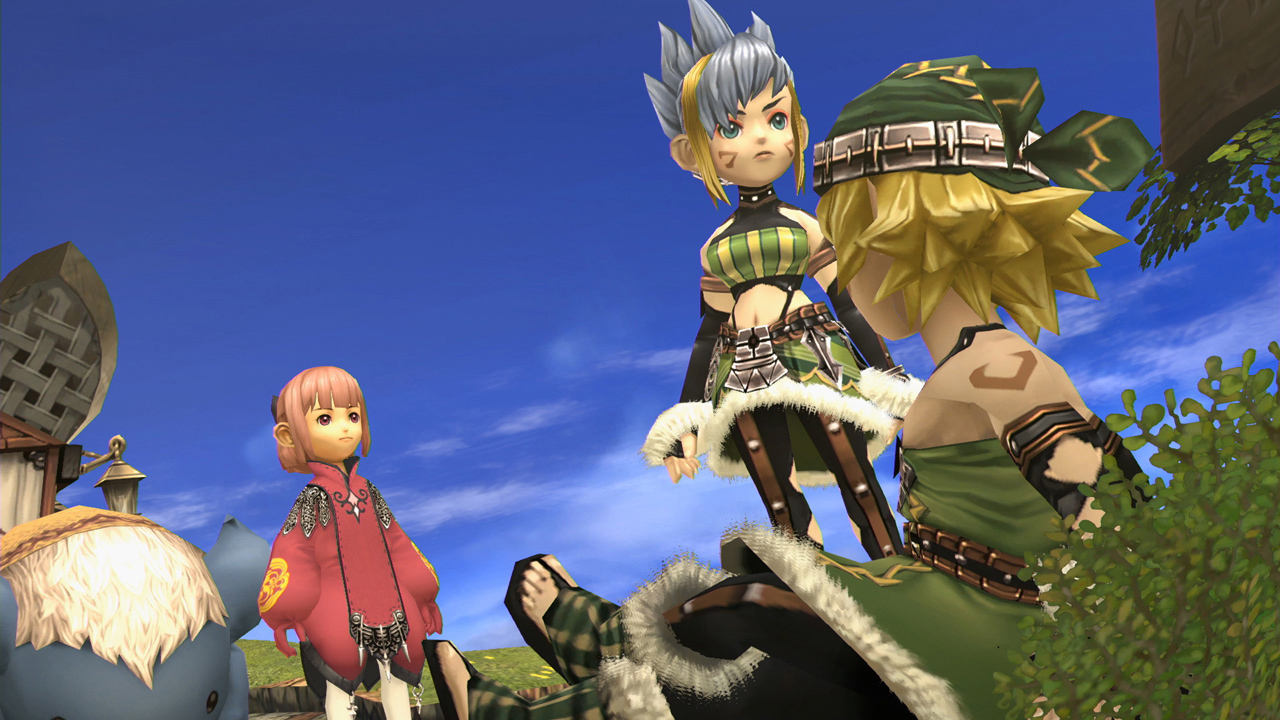
If you don’t want to bother with the hassle of trying to connect to others, figuring out the multiplayer menus, or simply coordinating play times and hosting with friends, you can still completely enjoy this game on your own. The single-player is by no means an inaccessible way of playing the game, and the plot and gameplay both hold up enough that I’d say it’s worth getting through regardless of whether or not you can make the multiplayer work. Sometimes, I find myself enjoying the single-player just as much if not more than the multiplayer because, in a way, it’s so much simpler. I found that to be true on the GameCube version, and I find that to be just as true with the remaster. When it comes to the single-player, the only differences between the two are the other, not as consequential remaster changes.
What else got remastered?
So, I’ve gone on plenty about the way Square Enix has altered the multiplayer for the remaster. But what about everything else?
For one, the game looks gorgeous. I thought the game looked gorgeous on GameCube. And I’m not going to sit here and argue that it had the greatest graphics of all time, but the art style was and still is a massive inspiration to me as an artist, and I find that it fits the world so perfectly that even back then it was pretty. But in terms of graphical quality, the remaster has unsurprisingly outdone itself. Environments look smooth and vibrant and colorful, and character models look more expressive and just as equally adorable as their older counterparts.
The new additions to the game, like the new extra character designs for each of the four tribes, the mimic feature, and voice acting, are all welcome additions as well. It’s clear to me that the developers of this game cared enough to have wanted to give us something new to look forward to with the re-release of this game, and as an old player I especially appreciate that. I actually find the voice acting, which I wouldn’t have told you was necessary in the past, to be one of the most welcome changes. It fits much better than I would have predicted prior to seeing it in action, and I’d say I even prefer it to the silent text that was present on the GameCube.
The new dungeons are a fantastic addition as well. While they’re by no means necessary to play through, they provide a great challenge for newbies and veterans of the title alike — and I say that as someone who finds the end of the base game to be pretty difficult on its own. I’m not one to ever say that extra content is a bad thing, but the dungeons are more than I could have expected and make for a much more fun test of skill than I might have thought.
Oh, and lastly: Donna Burke came back to do a re-recording of the intro song. And just as expected, it slaps.
The soundtrack
While we’re on the topic of music, I just want to touch on the soundtrack for a hot minute. While the music isn’t new per se, I do think it’s important to mention because I’m a firm believer that Crystal Chronicles has one of the best game soundtracks I’ve ever heard, especially if we’re talking within the fantasy realm. Seriously, if you’re ever looking for fantasy writing inspo or a soundtrack for a D&D game, put the music from this game on in the background and I guarantee you’ll find something you like.
Every track in this game is memorable, even if that’s not immediately evident. I’m almost positive that at this point, I can hear any of the dungeons’ main theme and hum it back with the game, almost like muscle memory. It’s a soundtrack that’s worth paying attention to, and if you walk away from this game with literally only one thing, I’d argue it should be the music — even if it has nothing to do with the remaster specifically.
The music of Crystal Chronicles absolutely makes the game whole. Do yourself a favor and go listen to a few tracks if you can. You won’t regret it.
Final thoughts
Throughout my childhood, my brother was my main partner in crime when it came to this game. When he and I first saw the reveal of this remaster, I don’t think either one of us fully believed it. It felt like someone was playing a joke on us. It felt too good to be true. Because honestly, Crystal Chronicles is not a game I ever, ever, thought would see the light of day again. It’s so niche, so obscure, and I’d argue more of a cult classic at this point than a recognizable favorite. Pair that with the fact that its gameplay and multiplayer methods were so convoluted and required so much effort, that it never in a million years would have crossed my mind as something worth even considering for a remaster.
And at the end of the day… maybe I was right about that. I’m not sure — it’s hard to tell. I think my final thoughts on this game are complicated, because there are real draws to bringing archaic multiplayer into the modern gaming era, with updated functionality. But, as we now know, there are big risks, too, and a potential to flop hard.
And while I don’t think Square Enix necessarily flopped, I think they faltered where it mattered most, and that comes at a cost. Like I said at the beginning of this review: I’m not mad they released this again, or remastered it. I’m anything but. There’s not a part of me that will ever tell you that Crystal Chronicles is a bad game or not worth playing. But, I do think there’s something to be said about leaving a good thing alone. That our memories of something can be treasures in their own right. And that sometimes, there isn’t anything wrong with leaving them as just that.
Leave a Comment
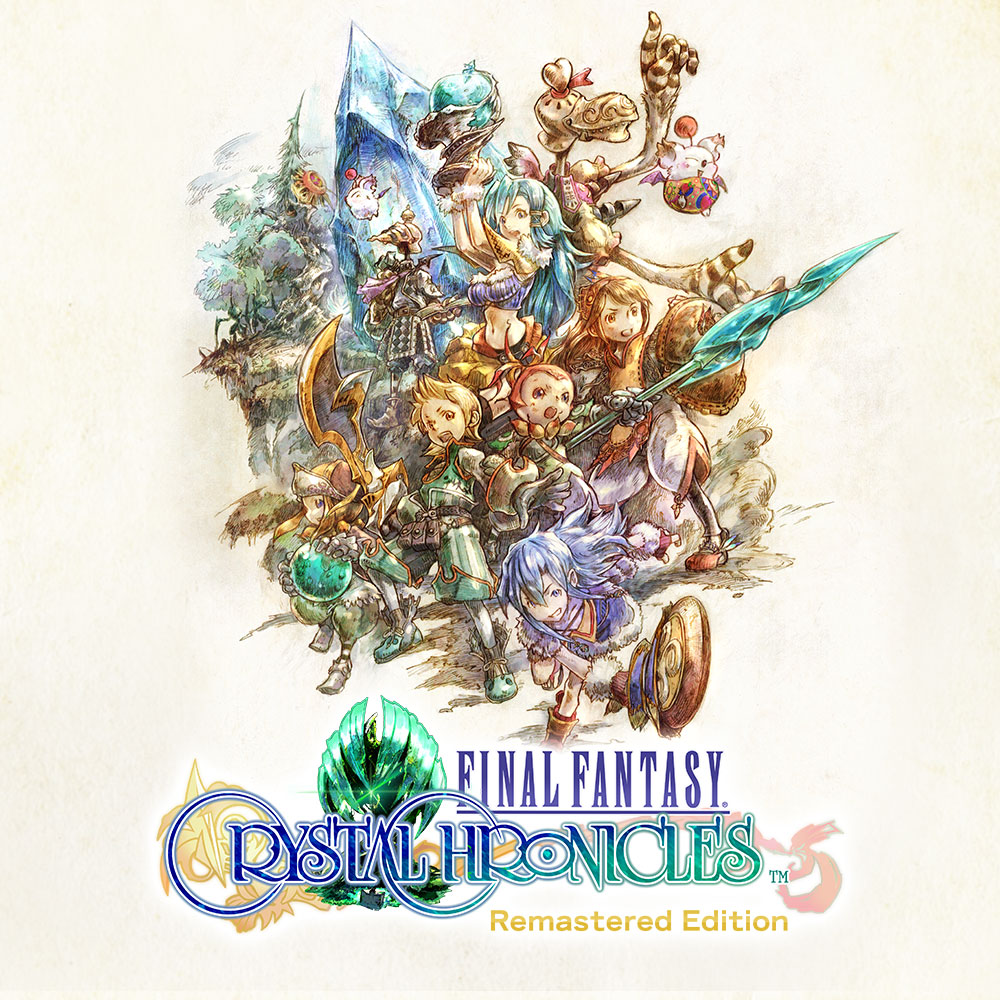
System: Nintendo Switch
Release Date: August 27, 2020
Categories: RPG
Publisher: Square Enix
Developer: Square Enix
